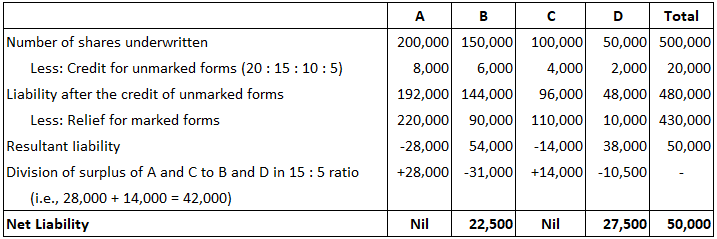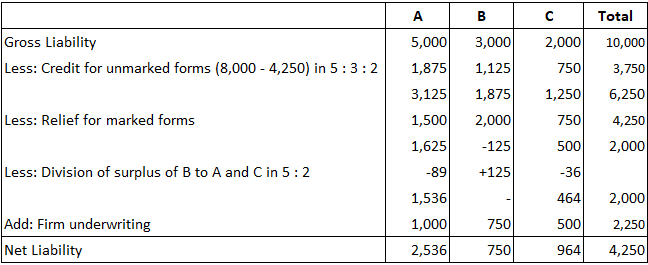A company issued 100,000 shares valued at $100 per share. The shares were underwritten as follows: The public applied for 70,000 shares. Required: Determine the liability of X, Y, and the company. Marked applications are not given in the problem. Therefore, applications are credited to underwriters, including the company, based on gross liability. The company itself should be treated as an underwriter for 20,000 shares. Alternatively, the calculations can be made as follows: A company that was incorporated on 1 January 2019 issued a prospectus inviting applications for 500,000 equity shares at $10 each per share. The whole issue was fully underwritten by four individuals, as shown in the following: Applications were received for 450,000 shares, of which the marked applications were as follows: Required: Calculate the liabilities of individual underwriters. Note: When the entire issue is underwritten by a single underwriter, it is not necessary to distinguish between marked and unmarked applications. In this case, the liability for the underwriter would be 50,000 shares. John Limited issued 10,000 shares valued at $100 each. The entire issue was underwritten as follows: In addition, there was firm underwriting as follows: The total subscription, including firm underwriting, was 8,000 shares. The subscription included the following marked applications: Required: Calculate the liability of the underwriters. The following underwriting takes place: In addition, there is firm underwriting: The shares issued amount to 10,000 shares. The total subscription, including firm underwriting, was 8,500 shares, and the forms included the following marked forms: Required: Calculate the allocation of liability of the underwriters. A company issued a prospectus inviting applications for 20,000 equity shares valued at $100 per share. The whole issue was fully underwritten by three underwriters as follows: Applications were received for 16,000 shares, of which marked applications were as follows: Required: Show how the liability of the underwriting should be completed.Underwriting of Shares
Question 1: Partial Underwriting
Answer


Question 2: Full Underwriting
Answer


Question 3: Firm Underwriting
Answer

Question 4
Answer

Question 5
Answer:

Underwriting of Shares: Questions and Answers FAQs
Underwriting of shares is the sale and purchase of shares on a stock market by an underwriter or group of underwriters.
Underwriting ensures the success of the proposed issue of shares since it provides insurance against the risk. It also enables a company to get the required minimum subscription. Even if the public fails to subscribe, the underwriters will fulfill their commitments.
The main problem for underwriting of shares is it usually involves a lot of risk and is therefore not undertaken lightly.
In the securities market, underwriting involves determining the risk and price of a particular security. It is a process seen most commonly during initial public offerings, wherein investment banks first buy or underwrite the securities of the issuing entity and then sell them in the market.
Only a registered broker-dealer may underwrite shares.
True Tamplin is a published author, public speaker, CEO of UpDigital, and founder of Finance Strategists.
True is a Certified Educator in Personal Finance (CEPF®), author of The Handy Financial Ratios Guide, a member of the Society for Advancing Business Editing and Writing, contributes to his financial education site, Finance Strategists, and has spoken to various financial communities such as the CFA Institute, as well as university students like his Alma mater, Biola University, where he received a bachelor of science in business and data analytics.
To learn more about True, visit his personal website or view his author profiles on Amazon, Nasdaq and Forbes.











